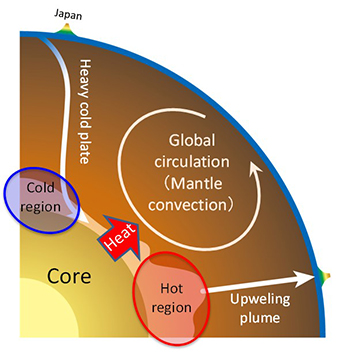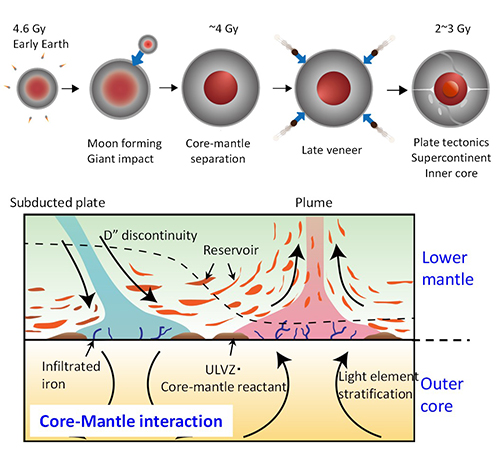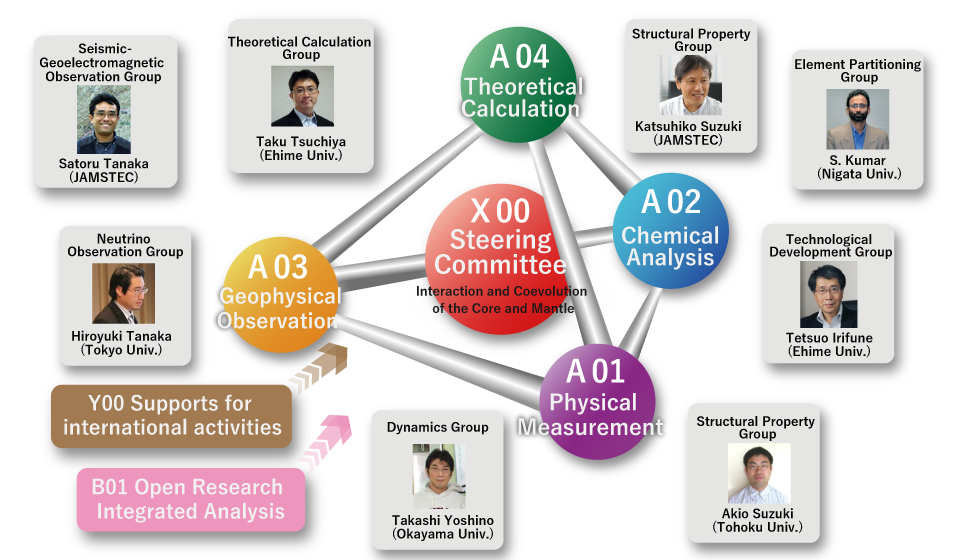Purpose of the Research Project

Recent observational and experimental investigations have significantly advanced understanding of the structure and constituent materials of the deep Earth. However, details of the chemical composition of the mantle, accounting for 80% of the volume of the entire Earth, and light elements expected to exist in the core, corresponding to the remaining 20%, have remained unclear for over 60 years. Seismological evidence has suggested a vigorous convection at the core-mantle boundary region, whereas geochemistry has suggested the presence of stable regions that hold the chemical signature of early Earth’s formation 4.6 gigayears ago. In addition, the amounts and types of radioactive isotopes that act as the heat sources that drive the dynamic behaviors of the deep Earth are also still largely unknown. We will elucidate these unresolved mysteries of deep Earth science through comprehensive investigations of the interactions between the core and mantle by combining high-pressure and high-temperature experiments, microscale geochemical analysis, high-resolution geophysical observations, and large-scale numerical simulations.
Content of the Research Project

Our research target is to clarify the major unsolved mysteries in deep Earth science by focusing on the core-mantle interaction and coevolution by fusing different research fields that have developed individually in Earth and planetary sciences.
In our research program, we promote the study of several specific and important topics: (1) detailed compositional properties of the mantle and core including radioactive isotopes, (2) the relationship between the origin of the heterogeneities in the core-mantle boundary region and stable regions (primordial reservoir), and (3) chemical stratification of the outer core and the heterogeneity in the inner core. In order to perform these studies, an unprecedented and wide cross-disciplinary research structure consisting of five research units is organized (A01: Physical property measurement, A02: Geochemical analysis, A03: Geophysical observation, A04: Theory and computation, and B01: Integrated analysis), where researchers from a variety of different fields participate. Summarizing outcomes obtained from all the research units, we will create an integrated new and dynamic model/vision of deep Earth science.
Expected Research Achievements and Scientific Significance
The collaboration of world leading research fields in high-pressure Earth science, geochemistry, global seismology, and the more recently developed neutrino geophysics could make great contributions to inventing a new research direction in deep Earth science. This program could greatly enhance our understanding of the core-mantle coevolution system dominating Earth’s internal dynamics and evolution. Development of talented human resources through the advanced researches is also of great significance in our program.
Research Units



![]()
A community of high pressure earth science in Japan has been cited a number of achievements in pioneering research to target the composition and structure of the deep Earth, and has contributed to the understanding of the global deep structure of the Earth and planets. However, it is hard to say that the core-mantle interaction such as the heat and material transfers across the core-mantle boundary has been understood well. The main driving force of the convective flow expected in the mantle is a positive heat flow from the core throughout the Earth’s secular cooling. The heat flow has controlled not only the mantle convection governing the dynamic process observed at the surface but also outer core convection generating the dynamo. These processes would have affected the inhomogeneous physical properties and the plastic flow of the deep Earth. This research project treats the core-mantle system as not separate system but a single system. In this group, we have determined the viscosity, flow law, and the preferred orientation of each of the major constituents of the inner core and the lower mantle by means of high-pressure deformation experiment. In addition, the physicochemical properties related to heat and mass transports across the core-mantle boundary such as thermal conductivity, element diffusion and so on will be determined by means of high-pressure experiments. Comparison with results obtained from geophysical monitoring, the global deep Earth dynamics including core and mantle is intended to comprehensively elucidate the core-mantle interactions.
![]()
Advanced experimental techniques are needed for precise measurements of melting and phase relations, element partitioning, and physical properties of minerals under very high pressures and temperatures of the lower mantle and the core. We develop state-of-the-art high-pressure technology using various novel ultrahard materials, including binderless tungsten carbide, low-binder sintered polycrystalline diamond, and pure nano-polycrystalline diamond developed by the Geodynamics Research Center, according to the required pressure/temperature conditions for studies on the interaction and coevolution of the Earth’s core and mantle. Thus developed technology is transferred to other research groups to enhance their studies relevant to these scientific themes. The members of this group themselves involve in these studies in collaboration with those of other groups, particularly on the following subjects; 1) partitioning of some key elements between silicate and iron melts under the lower mantle conditions to constrain the process of core formation and the composition of the lower mantle, 2) stabilities of hydrous and other volatile-bearing minerals to understand the global circulation and the roles of light elements in the dynamic processes of the deep mantle, 3) local structures of elements in silicate and iron melts, and 4) physical properties of high-pressure minerals critical to understand dynamic processes in the deep mantle and the core.

![]()
Chemical composition of the Earth’s interior and its evolution through time have been often “inferred” from meteorites and to some extent rely on the information obtained from deep mantle xenoliths. However, we are still not sure of exact chemical composition of the Earth’s deep interior and how it has evolved through time. Through this project we intend to understand the element partitioning between different phases in the deep Earth, especially in the core-mantle boundary. In particular, we focus on the mobility of light elements and highly siderophile element and their partitioning between silicate minerals, metals and melts of various compositions. Experimental studies will will be carried out at lower mantle to outer core conditions to unravel the mysteries of missing elements in the Earth compared to other planets in the solar system.The recent developments in geochemical analytical techniques in the micrometer to nanometer scale using laser-based and ion-probe based techniques will be combined with the advances in high-pressure high-temperature experimental techniques to gather basic information on partitioning of elements in the deep earth. Interacting closely with other groups, we hope to put forward a comprehensive model on mobility of elements, materials and melts across the core-mantle boundary.

![]()
Seismological and geo-electromagnetic studies for the deep structure of the Earth to date have provided a static image of the Earth’s interior. However, there have been a few contributions to the understanding of the dynamic behavior of materials in the deep Earth. In this project, we seek to develop an integrated understanding of the Earth’s deep interior based on a new viewpoint: co-evolution of the core and mantle by geophysical observation. For example, to understand deformation mechanisms in the deep Earth, observations of seismic azimuthal anisotropy and attenuation of seismic waves in the lowermost mantle would be required. Studies of D” discontinuities would be useful to determine the temperature and its gradient at the base of the mantle with a combination of experimental and theoretical phase diagrams, which control thermal transport. Electric conductivity at the CMB that is related to thermal conductivity and can be constrained by a geophysical observation. We will address such issues by using a large data set comprising previously undisclosed data from foreign sources and from observations collected during a new mobile deployment.
![]()
One decade has elapsed since geoneutrinos were first detected at KamLAND. The data have been accumulated since then, and now it is possible for us to measure the radioactive elements deep inside the Earth. Although various questions are still opened for the source of radiogenic heat in the mantle, our investigation is underway to reach the successful model to explain the core-mantle thermal evolution. In this work, the accuracy of the geoneutrino flux modeling in the KamLAND region will be improved in conjunction with geoscientific knowledge, and thus, Earth’s uranium and thorium concentrations will be more accurately measured after further accumulation of the geoneutrino data at KamLAND in the next 5 years. Also, the directionally sensitive anti-neutrino detector will be developed.

![]()
Extreme environments such as deep Earth high-pressure and high-temperature condition and geological time scale are reproduced by computer simulations. Focus topics are (1) Chemical composition of the mantle, light elements in the core, and distribution of radioactive elements (2) relationship between heterogeneity observed around the core-mantle boundary and geochemical reservoir, and (3) origins of chemical stratification in the outer core and heterogeneous structure in the inner core. Essential factors of the core-mantle coevolution that yielded Earth’s wide variation are picked up and modeled. Theoretical supports and interpretations are provided to experimental and observed data.

This unit works to build international networks related to the project, promote international collaborations, and dispatch research activities. Major aims are strengthening relationships to hub communities in America, Europe, and Asia and enhancing personnel exchanges. International educational activities for young researchers are also targeted.
Logo






